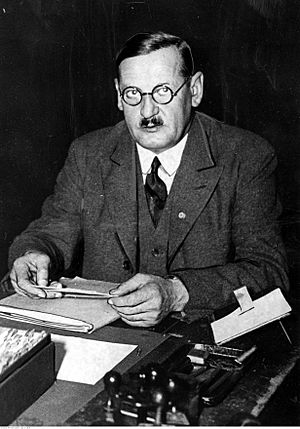Anton Drexler facts for kids
Quick facts for kids
Anton Drexler
|
|
|---|---|

Drexler in 1920
|
|
| Chairman of the Nazi Party | |
| In office 24 February 1920 – 29 July 1921 |
|
| Preceded by | Position established |
| Succeeded by | Adolf Hitler (as dictatorial Führer of the party) |
| Chairman of the German Workers' Party | |
| In office 5 January 1919 – 24 February 1920 |
|
| Deputy | Karl Harrer |
| Preceded by | Position established |
| Succeeded by | Position abolished |
| Personal details | |
| Born | 13 June 1884 Munich, German Empire |
| Died | 24 February 1942 (aged 57) Munich, Nazi Germany |
| Nationality | German |
| Political party | Nazi Party (1920–1923, 1933–1942) |
| Other political affiliations |
German Fatherland Party (1917–1918) German Workers' Party (1919–1920) Völkisch-Social Bloc (1924–1928) |
| Occupation | Locksmith Tool and die maker |
| Awards | Blood Order Golden Party Badge |
Anton Drexler (born June 13, 1884, died February 24, 1942) was a German politician. He was involved in extreme right-wing politics in the 1920s. He started a group called the German Workers' Party (DAP). This group later became the Nazi Party (NSDAP). Drexler helped Adolf Hitler when Hitler was new to politics.
Contents
Early Life of Anton Drexler
Anton Drexler was born in Munich, Germany. He worked as a machine-fitter and later as a locksmith. He did not join the army during World War I. This was because he was not physically fit enough to serve.
Drexler's Political Beginnings
During World War I, Drexler joined the German Fatherland Party. This was a short-lived political group. In March 1918, Drexler started a local group called the Free Workers' Committee.
Later in 1918, a journalist named Karl Harrer suggested a new group. Drexler and others formed the Political Workers' Circle. Members of this group met regularly. They discussed ideas about nationalism and antisemitism.
Founding the German Workers' Party
Anton Drexler and Karl Harrer founded the German Workers' Party (DAP). This happened in Munich on January 5, 1919.
In September 1919, Adolf Hitler attended a DAP meeting. Hitler was there to observe political groups for the German Army. During the meeting, Hitler got into a strong argument. He impressed the other members with his powerful speaking skills.
Drexler noticed Hitler's talent. He gave Hitler a copy of his pamphlet, My Political Awakening. This pamphlet contained ideas against Jewish people and against capitalism. Drexler encouraged Hitler to join the DAP. Hitler joined the party as ordered by his army superiors.
The Rise of the Nazi Party
Once Hitler joined, he helped the DAP become more public. He used his speaking abilities to attract many people. He organized a large meeting in Munich on February 24, 1920. About 2,000 people attended this event.
At this meeting, Hitler announced the party's new goals. These goals included ending the Treaty of Versailles. They also called for a "Greater Germany" and removing Jewish people from citizenship. On the same day, the party changed its name. It became the National Socialist German Workers' Party (NSDAP), also known as the Nazi Party.
Drexler's Role Changes
Hitler resigned from the party on July 11, 1921, after a disagreement. The party leaders knew that losing Hitler would harm the party. They asked Dietrich Eckart to speak with Hitler.
Hitler agreed to return but with conditions. He wanted to replace Drexler as party chairman. He also wanted to have complete power and the title of "Führer". The party leaders agreed to his demands.
Drexler was then given an honorary position. He left the party in 1923.
Later Years
Drexler was also a member of the Thule Society. This was a political club for wealthy people in Munich. His membership in the Nazi Party ended when it was banned in 1923. This happened after the Beer Hall Putsch, a failed attempt to take power. Drexler did not take part in this event.
In 1924, Drexler was elected to the Bavarian state parliament. He served as vice president until 1928. He did not play a role when the Nazi Party was re-formed in 1925. He rejoined the party only after Hitler became powerful in 1933.
Drexler received the Nazi Party's Blood Order in 1934. He was sometimes used for propaganda until about 1937. However, he was never given any real power within the party again.
See also
 In Spanish: Anton Drexler para niños
In Spanish: Anton Drexler para niños

